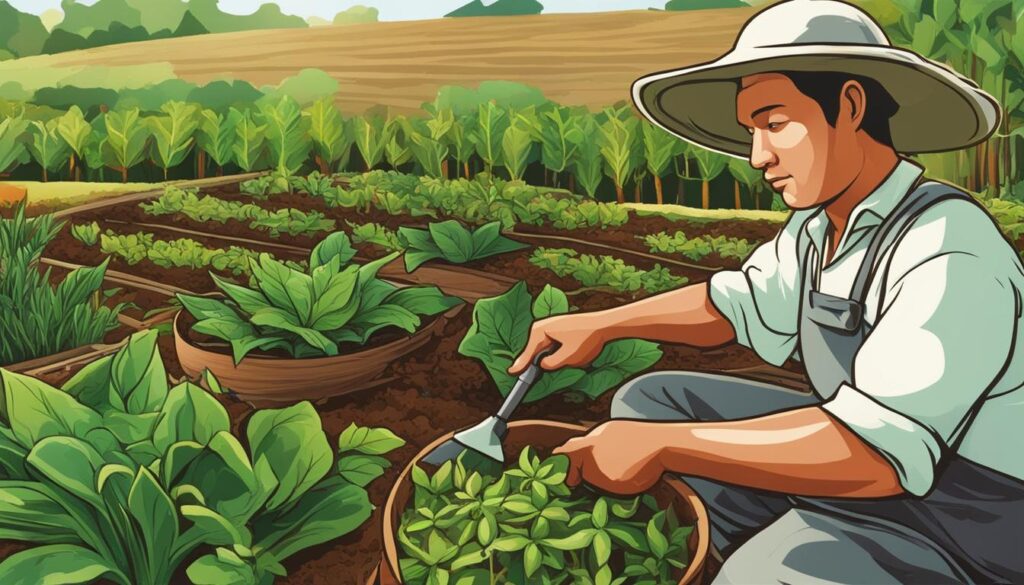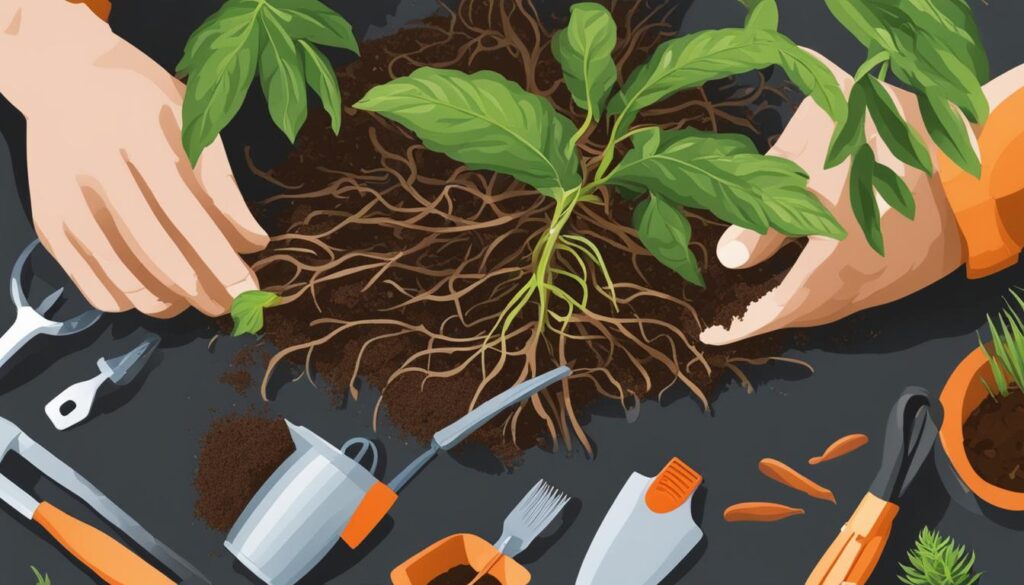Growing Eurycoma Longifolia, also known as Tongkat Ali, can be a rewarding experience for gardeners. This comprehensive guide will provide you with all the information you need to cultivate and care for your Eurycoma Longifolia plants.
Key Takeaways:
- Learn the ideal growing conditions for Eurycoma Longifolia, including temperature, sunlight, soil type, and watering requirements.
- Discover tips on how to propagate Eurycoma Longifolia and maintain its health.
- Understand the pros and cons of growing Eurycoma Longifolia outdoors versus indoors.
- Follow step-by-step instructions for planting, caring, fertilizing, and pest management.
- Find out when and how to harvest Eurycoma Longifolia for maximum medicinal benefits.
In conclusion, growing Eurycoma Longifolia can be an enriching and beneficial endeavor for gardeners. By following the guidelines and tips outlined in this article, you can cultivate a thriving Eurycoma Longifolia garden and enjoy the medicinal benefits of this remarkable plant. Remember to adapt the cultivation practices to your specific climate and conditions for the best results. Happy growing!
Understanding Eurycoma Longifolia
Eurycoma Longifolia, also known as Tongkat Ali, is a tropical plant that is native to Southeast Asia. It is highly regarded for its medicinal properties and has been used for centuries in traditional medicine. In recent years, interest in cultivating Eurycoma Longifolia has grown as more people recognize its potential benefits. In this section, I will provide an overview of Eurycoma Longifolia, including its ideal growing conditions and best practices for cultivating this remarkable plant.

Characteristics of Eurycoma Longifolia
Before delving into the farming techniques, it’s important to understand the key characteristics of Eurycoma Longifolia. This perennial plant boasts long, slender leaves and small, yellow flowers. Its roots are a highly sought-after part of the plant, as they contain beneficial bioactive compounds. Eurycoma Longifolia is known for its ability to increase testosterone levels, improve sexual function, enhance athletic performance, and boost overall vitality.
Ideal Growing Conditions
Eurycoma Longifolia thrives in warm, tropical climates with abundant sunlight. It requires a temperature range of 75 to 95 degrees Fahrenheit (24 to 35 degrees Celsius) for optimal growth. The plant prefers well-draining soil that is rich in organic matter. Adequate moisture is essential, and regular watering is recommended, especially during dry periods. However, it’s important to avoid overwatering, as excessive moisture can lead to root rot.
In terms of sunlight, Eurycoma Longifolia requires at least six hours of direct sunlight per day. If you are growing the plant indoors, ensure that it has access to sufficient sunlight by placing it near a sunny window or using grow lights. It’s also crucial to maintain proper humidity levels, as Eurycoma Longifolia thrives in high humidity environments.
Propagation and Maintenance
Eurycoma Longifolia can be propagated through seeds or root cuttings. Seeds should be soaked in water for 24 hours before planting to enhance germination. It’s recommended to plant the seeds in a seed tray filled with well-draining potting mix. Keep the soil consistently moist until the seeds germinate, which typically takes around two to three weeks.
Once the plants are established, regular maintenance is essential for their healthy growth. This includes regular watering, fertilizing with a balanced organic fertilizer, and providing support to the plants as they grow taller. It’s important to monitor for pests and diseases, such as aphids and fungal infections, and take appropriate measures to control them.
| Key Points | Benefits |
|---|---|
| Eurycoma Longifolia is a tropical plant native to Southeast Asia | Medicinal properties, including increased testosterone levels and improved sexual function |
| Requires warm, tropical climates and abundant sunlight | Enhanced athletic performance and increased vitality |
| Well-draining soil and regular watering | Rich source of bioactive compounds |
| Propagation through seeds or root cuttings | Possible use in traditional medicine |
By understanding the unique characteristics of Eurycoma Longifolia and providing it with the ideal growing conditions, you can cultivate a thriving garden of this remarkable plant. In the next section, we will explore the different options for choosing the right location to grow Eurycoma Longifolia, whether it’s in an outdoor garden or indoor container.
Choosing the Right Location
Eurycoma Longifolia, also known as Tongkat Ali, can be grown both outdoors and indoors, providing flexibility for gardeners based on their climate and space availability. It is essential to select the right location for your Eurycoma Longifolia garden to ensure optimal growth and yield. Let’s explore the pros and cons of outdoor cultivation and growing Eurycoma Longifolia indoors.
Outdoor Cultivation of Eurycoma Longifolia
Outdoor cultivation of Eurycoma Longifolia offers several advantages. The plants can benefit from natural sunlight and exposure to varying weather conditions, which can enhance their overall growth. Additionally, outdoor gardens allow for larger planting areas, which can accommodate more Eurycoma Longifolia plants for increased yield. However, it is crucial to consider your climate and geographical location before opting for outdoor cultivation.
When choosing an outdoor location for your Eurycoma Longifolia garden, ensure that the area receives ample sunlight, preferably at least 6-8 hours of direct sunlight per day. The soil should be well-draining and rich in organic matter to promote healthy root development. Avoid areas prone to waterlogging or excessive moisture, as this can lead to root rot and other fungal diseases. It is recommended to perform a soil test to determine the pH level and make necessary adjustments to create an ideal growing environment for Eurycoma Longifolia.
Growing Eurycoma Longifolia Indoors
If you have limited outdoor space or live in a climate that is not suitable for outdoor cultivation, growing Eurycoma Longifolia indoors can be a viable option. Indoor cultivation allows for better control over environmental factors such as temperature, humidity, and lighting. It also offers year-round growing opportunities, irrespective of the external weather conditions.
When selecting an indoor location for your Eurycoma Longifolia plants, choose a spot that receives bright, indirect sunlight for at least 6-8 hours a day. Supplemental grow lights can be used to provide sufficient light intensity during the winter months or in areas with limited natural light. Maintain a temperature range of 75-85°F (24-29°C) and humidity levels between 60-80% to mimic the tropical conditions that Eurycoma Longifolia thrives in. Adequate ventilation is also crucial to prevent the buildup of high humidity and stagnant air, which can promote disease development.
The choice between outdoor and indoor cultivation ultimately depends on your specific circumstances and preferences. Consider factors such as available space, climate, and your ability to provide the necessary care for your Eurycoma Longifolia plants. By selecting the right location, you can create an optimal environment for their growth and successfully cultivate this remarkable plant.
| Outdoor Cultivation | Indoor Cultivation | |
|---|---|---|
| Advantages |
|
|
| Considerations |
|
|
Tips for Growing Eurycoma Longifolia
Proper planting and care techniques are essential for the successful growth of your Eurycoma Longifolia garden. Here are some tips to help you cultivate healthy plants and achieve maximum yield:
- Choose a well-draining soil: Eurycoma Longifolia plants prefer slightly acidic soil with good drainage. Amend the soil with organic matter like compost to improve its structure and nutrient content.
- Provide the right amount of sunlight: Eurycoma Longifolia thrives in full sun to partial shade. Ensure your plants receive at least 6 hours of direct sunlight daily for optimal growth.
- Water regularly but avoid overwatering: Keep the soil consistently moist but not waterlogged. Water your plants deeply once or twice a week, depending on the weather conditions. Adjust the frequency based on your climate and the moisture retention of your soil.
- Fertilize appropriately: Eurycoma Longifolia plants benefit from regular feeding. Use a balanced organic fertilizer with a ratio of 10-10-10 or a specialized fertilizer for flowering plants. Apply the fertilizer according to the instructions on the packaging.
- Watch out for pests and diseases: Monitor your plants regularly for signs of pests like aphids or diseases like root rot. Treat any infestations or infections promptly using organic insecticides or fungicides, if necessary.
- Prune for better growth: Pruning helps promote bushier growth and enhances airflow around the plants. Remove dead or damaged branches, and trim back any excessive growth to maintain the desired shape.
By following these tips, you can ensure that your Eurycoma Longifolia plants thrive and produce the desired medicinal benefits.

Testimonials from Successful Growers
“I’ve been growing Eurycoma Longifolia for years, and it’s incredibly rewarding. Following these tips has helped me achieve healthy plants and a bountiful harvest. Highly recommended!” – Jane, experienced gardener
“As a beginner, I was initially hesitant to grow Eurycoma Longifolia, but with these valuable tips, I’ve been able to establish a successful garden. Thank you!” – Mark, novice gardener
Growth Comparison Table
| Variety | Height | Flowering Time | Yield |
|---|---|---|---|
| Variety A | 3-4 feet | 12-16 weeks | High |
| Variety B | 2-3 feet | 8-12 weeks | Moderate |
| Variety C | 4-5 feet | 16-20 weeks | Low |
Note: The growth and yield of Eurycoma Longifolia may vary depending on various factors, including growing conditions, soil quality, and care practices.
Harvesting and Utilizing Eurycoma Longifolia
When it comes to cultivating Eurycoma Longifolia, knowing the right time to harvest is crucial to fully harness its medicinal benefits. Let’s explore the various parts of the plant that can be harvested and how they can be utilized.
Harvesting Roots
The roots of the Eurycoma Longifolia plant contain the highest concentration of beneficial compounds. To harvest the roots, gently dig around the base of the plant, making sure not to damage the roots. Carefully lift the plant out of the ground, and gently shake off excess soil. Use clean scissors or a knife to remove the roots from the plant, ensuring that you leave behind a portion to allow for regeneration.
Harvesting Leaves
The leaves of Eurycoma Longifolia can also be harvested for various purposes. Choose the mature leaves that have a rich green color. Use clean scissors to cut the leaves close to the stem, being careful not to damage the plant. It’s best to harvest leaves in the morning when the plant’s moisture content is higher.
Harvesting Flowers
The flowers of Eurycoma Longifolia are less commonly harvested but can still be utilized. When the plant is in bloom, carefully snip the flowers at the base of the stem using clean scissors. Ensure that you have a sufficient number of flowers to meet your needs while allowing the plant to continue blooming.
| Part of Eurycoma Longifolia | Harvesting Time | Utilization |
|---|---|---|
| Roots | When the plant is at least 4 years old | To make extracts, herbal remedies, or supplements |
| Leaves | When the plant is mature | For making teas, tinctures, or topical applications |
| Flowers | When the plant is in bloom | Decoration or for making infused oils or teas |
Utilizing Eurycoma Longifolia varies depending on the harvested parts:
- Roots: The roots can be used to make extracts, herbal remedies, or supplements. They are typically dried, ground into a powder, and used in various preparations.
- Leaves: The leaves can be used to make teas, tinctures, or topical applications. They can be dried or used fresh, depending on the desired purpose.
- Flowers: While less commonly utilized, the flowers can be used for decoration or to make infused oils or teas.
Remember to handle harvested parts with care and store them in a cool, dry place to preserve their potency. By following proper harvesting techniques and utilizing the various parts of the Eurycoma Longifolia plant, you can make the most of this remarkable botanical treasure.
Troubleshooting and Common Issues
When cultivating Eurycoma Longifolia, you may encounter various challenges along the way. It is important to be aware of common problems and have the knowledge to troubleshoot them effectively. In this section, I will address some of the most frequent issues that gardeners face when growing Eurycoma Longifolia and provide practical solutions to overcome them.
Pest Infestations
Pests can cause significant damage to your Eurycoma Longifolia plants if left unaddressed. Some common pests that may affect your garden include aphids, mealybugs, and spider mites. To tackle these infestations, it is crucial to regularly inspect your plants for any signs of pests. If detected, you can use insecticidal soaps or organic pest control methods to eliminate them. Alternatively, you can introduce beneficial insects such as ladybugs or lacewings to help control the pest population naturally.
Nutrient Deficiencies
Inadequate nutrient levels can lead to stunted growth and poor overall health of your Eurycoma Longifolia plants. Common nutrient deficiencies include nitrogen, phosphorus, and potassium. To address these deficiencies, you can use organic fertilizers or supplements specifically formulated for Eurycoma Longifolia. Regularly check the soil pH and adjust it if necessary to ensure optimal nutrient absorption.
Diseases and Environmental Stress
Eurycoma Longifolia can be susceptible to various diseases, such as root rot and leaf spot. To prevent disease outbreaks, ensure proper watering practices, allowing the soil to dry slightly between waterings to avoid waterlogged conditions. Additionally, maintain good airflow around the plants by spacing them adequately and removing any debris or dead leaves. Protect your plants from extreme temperatures, as they can cause stress and weaken their immune systems.
| Problem | Symptoms | Solution |
|---|---|---|
| Pest Infestations | Presence of insects, yellowing leaves, distorted growth | Use insecticidal soaps, introduce beneficial insects |
| Nutrient Deficiencies | Stunted growth, yellowing leaves, poor flowering | Use organic fertilizers, adjust soil pH |
| Diseases and Environmental Stress | Leaf spots, wilting, root rot | Proper watering, maintain good airflow, protect from extreme temperatures |
By being proactive in identifying and addressing these common issues, you can ensure the health and productivity of your Eurycoma Longifolia garden. Remember to regularly monitor your plants, practice good cultural care, and adjust your cultivation techniques accordingly. With proper troubleshooting and care, you can overcome any challenges and enjoy a thriving Eurycoma Longifolia garden.

Conclusion
In conclusion, growing Eurycoma Longifolia can be an enriching and beneficial endeavor for gardeners. By following the guidelines and tips outlined in this article, you can cultivate a thriving Eurycoma Longifolia garden and enjoy the medicinal benefits of this remarkable plant. Remember to adapt the cultivation practices to your specific climate and conditions for the best results. Happy growing!
